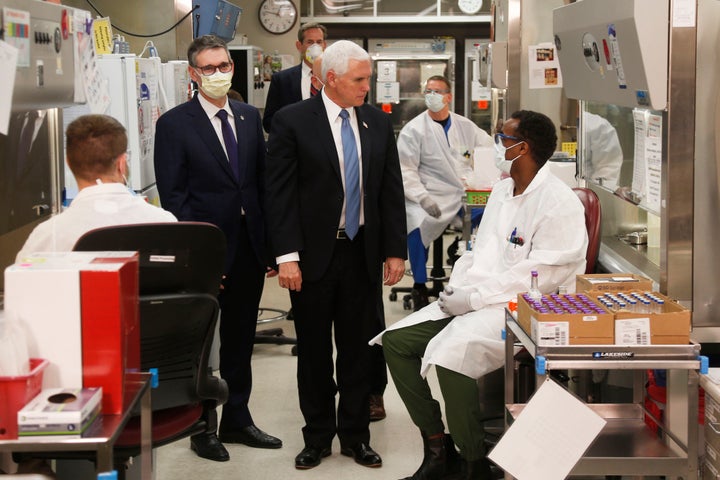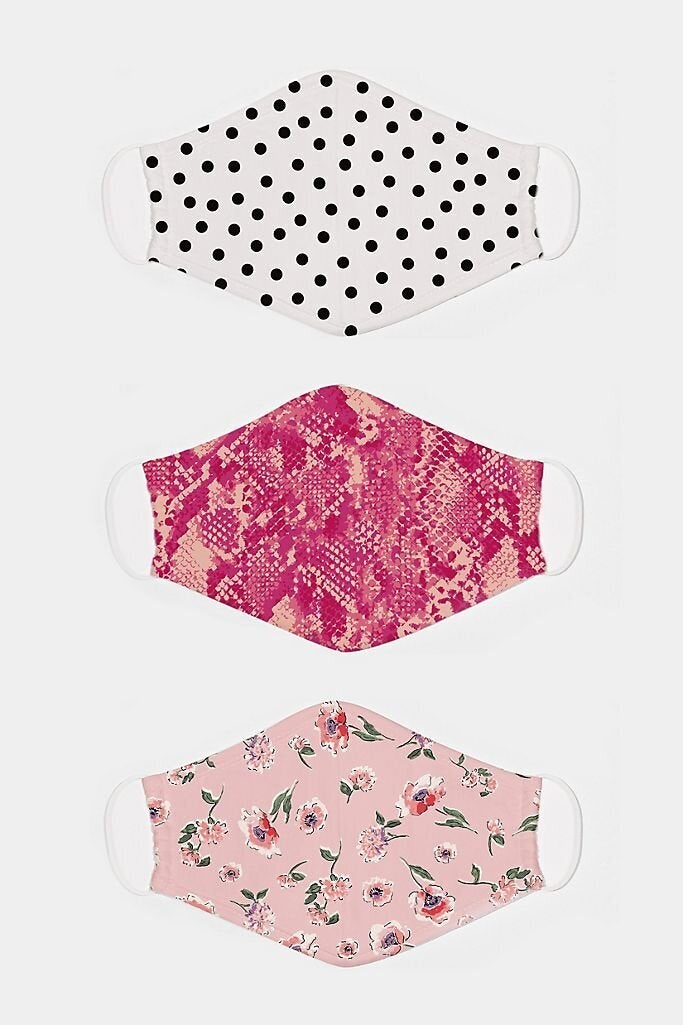In the early months of the coronavirus pandemic, Hélène Barcelo, the deputy director of the Mathematical Sciences Research Institute in Berkeley, California, was strolling around a park when she spotted a family of four all masked up. Well, almost all masked up: The mom was wearing a protective covering. So, too, were the children. But the father’s mask was hanging from his neck.
Barcelo is currently studying face mask usage, so the scene at the park piqued her interest. Later on, she brought it up when Skyping with her colleague Valerio Capraro, a senior lecturer in economics at Middlesex University in London.
“When I mentioned it, Valerio shared a similar story,” Barcelo told HuffPost. “He lives in London and saw several couples where the female was wearing a mask, while the male was not. So, we thought: ‘Perhaps there’s something in there, with men.’”
Spurred on by what they saw, the pair recently released a study that probes why men are more mask-resistant. The researchers polled 2,459 U.S. participants and found that men were more likely to opt out of wearing masks, believing them to be “shameful,” “a sign of weakness,” and “not cool” — in spite of the data showing that men are at higher risk than women of dying from a coronavirus infection.
The researchers also found that men were less likely than women to believe they would be seriously affected by the coronavirus.
“This was quite unexpected and somewhat ironic, given the fact that official statistics show that men are more likely than women to die from COVID-19,” Barcelo said.
Equally surprising to the researchers is that in counties where wearing a face mask was mandatory, those gender differences almost disappeared, though men still expressed the same negative emotions toward masks.
“In other words, in counties where wearing a face mask is mandatory, men dislike wearing it as they do in counties where wearing a face mask is not mandatory, but at least it increases their intentions to wear it,” she said.
That’s an especially important takeaway, given how slow some government officials have been to enact mask mandates and even to mask up themselves.
In spite of the CDC’s recommendation to wear masks in public places, Vice President Mike Pence notoriously went maskless while touring the Mayo Clinic facilities that support COVID-19 research and treatment. Though he later said he regretted the decision, his mask usage has still been spotty since.

After months of refusing to wear a mask in public and even questioning their efficacy, President Donald Trump seems to have come around to face coverings. On July 11, four months into the pandemic and with more than 134,000 Americans dead, the president finally slipped on a mask during a visit to Walter Reed National Military Medical Center.
Then, earlier this week, he shared a photo of himself wearing one.
“We are United in our effort to defeat the Invisible China Virus, and many people say that it is Patriotic to wear a face mask when you can’t socially distance,” Trump tweeted, making a racist reference to the coronavirus.
“There is nobody more Patriotic than me, your favorite President!” he added.
Still, the president has said he won’t endorse the mask mandate lawmakers like Sen. Elizabeth Warren (D-Mass.) have pushed for. And hours after tweeting the mask photo, he was seen mingling with supporters at a fundraiser, mask-free.
Inconsistent messaging, yes — but progress nonetheless, given Trump’s previous personal stance on face masks. (According to The New York Times, the president complained privately to staff that he thought it would make him look weak and would draw attention to the public health crisis.)
Trump and other men’s waffling on wearing a mask ― or their outright refusal to wear one ― isn’t surprising, said Shane G. Owens, a psychologist and the assistant director of campus mental health at Farmingdale State College SUNY.
“The results of the study reflect what we would expect, given gender roles in the U.S.,” Owens told HuffPost. Traits like “self-reliance, individualism, strength and courage” are stereotypically associated with masculinity, and in the eyes of many American men, “wearing a mask runs counter to most of those traits,” Owens said.
For many men rejecting the mask, “there’s a sense of rugged individualism and a desire to appear impervious to harm,” Owens said.
He said the study’s findings made a lot of sense when you contextualize them with men’s low prioritization of medical care and their health. Think of how many men shrug off annual check-ups with their doctor.
Owens was surprised by the study’s finding that appealing to men’s sense of family responsibility didn’t much increase their intention to wear masks, whereas appealing to their sense of community did.
“Maybe these men are thinking, ‘I don’t need anyone to tell me how to protect my family,’” Owens said.
“Masculinity can hinder men in a lot of ways – asking for directions, going to counseling, and wearing a mask for the coronavirus fits right in with these.”
- Kurt Smith, a therapist whose clients are mostly men, in Roseville, California
Kurt Smith, a therapist in Roseville, California, works primarily with men. He told HuffPost that he believes the demand for conformity on masks ― and sometimes, shaming people if masks aren’t worn ― causes some men to dig their heels in deeper.
“For example, I know people who’ve been screamed at in stores for not wearing a mask,” Smith said. “No one deserves to be treated this way. I think it just fuels further resistance.”
Couple that with the optics of wearing a mask ― “it makes me look unmanly,” some feel ― and you’ve got a solid recipe for mask resistance.
“Masculinity can hinder men in a lot of ways — asking for directions, going to counseling, and wearing a mask for the coronavirus fits right in with these,” he said.
A shame-based approach won’t work in convincing guys like that, Smith said, but friendly peer pressure might.
“Not wearing one can actually be more uncomfortable than doing so as you stick out so much when surrounded by so many people who are,” he said.
Talking about some of the nonmedical benefits can help buy-in, too, Smith said. They make you look kind of cool, like you’re going incognito, he joked.
Anecdotally, women sure seem to find a man in a mask attractive. Look at how much praise “Wonder Woman” actor Chris Pine got for wearing a mask after making a bookstore run in this viral tweet from a few weeks ago.
Sharing photos of good looking, masked-up actors won’t work for everyone, but Owens does think some kind of PSA campaign featuring public figures men admire wearing masks could be helpful.
“Get people guys idolize to wear masks,” he said. “An advertisement that shows men’s favorite sports team or other public figures wearing masks might be useful. Face coverings that sport the logos of favorite teams are a phenomenal idea.”
As the aforementioned study suggests, it also helps to appeal to people’s sense of community or patriotism.
Authorities relied heavily on patriotic messaging during the 1918 influenza epidemic, according to Alex Navarro, assistant director of the Center for the History of Medicine at the University of Michigan and one of the editors-in-chief of the American Influenza Epidemic of 1918-1919: A Digital Encyclopedia.
As Navarro told the Los Angeles Times recently, when the first mandatory mask orders in 1918 were met with opposition, public service announcements by the Red Cross and other groups urged people to “do their part,” deeming those who refused to get on board “slackers.”
This time around, Navarro said a focus on getting America back on track economically may be more effective.
“The message is, ‘We cannot have a normal economy until we get the pandemic under control,’ and that is not going to happen 100% until we get a vaccine,” he told the Times. “But we can get much closer to having it under control if people comply with social distancing and wearing a mask while in public.”
Barcelo and Capraro said they’re working on more research that suggests Americans respond particularly well to messages telling them to “rely on their reasoning” rather than their emotion. That was true of men and women, Barcelo said.
Still, as their first study showed, the biggest motivator of all remains a mandatory mask order.
“We did see that in counties where wearing face covering was mandatory, both men and women said they’d comply with that rule,” she said. “Making it mandatory everywhere would seem like an effective way to get through.”
Experts are still learning about the novel coronavirus. The information in this story is what was known or available as of press time, but it’s possible guidance around COVID-19 could change as scientists discover more about the virus. Please check the Centers for Disease Control and Prevention for the most updated recommendations.

